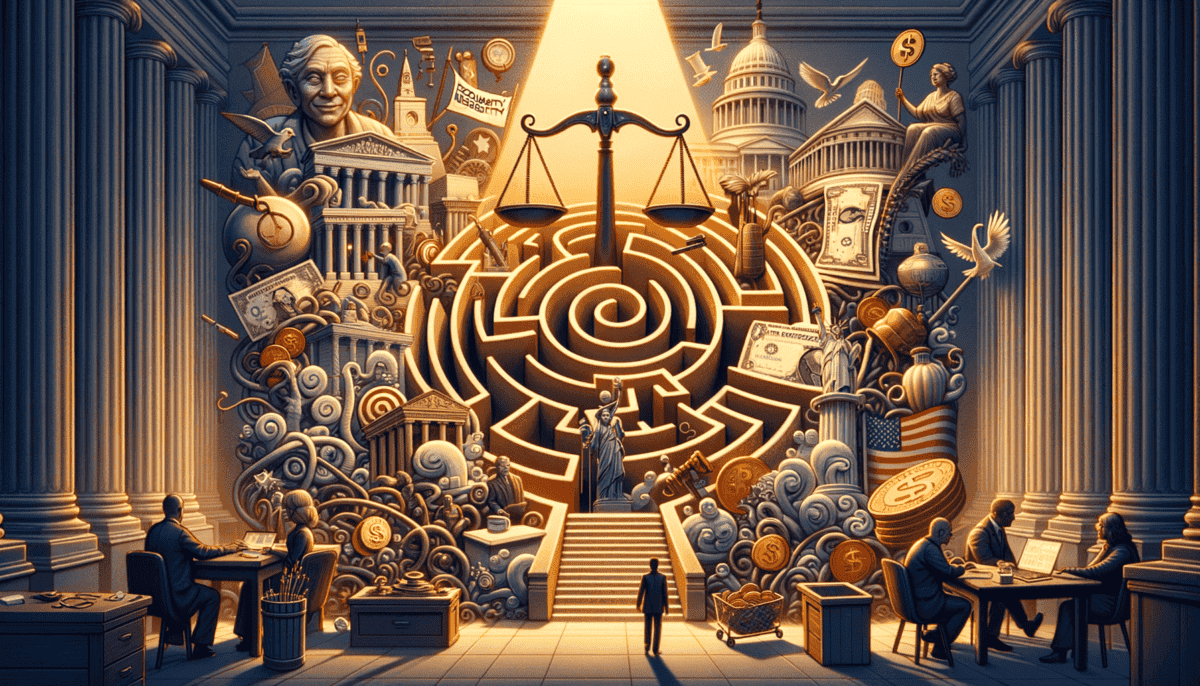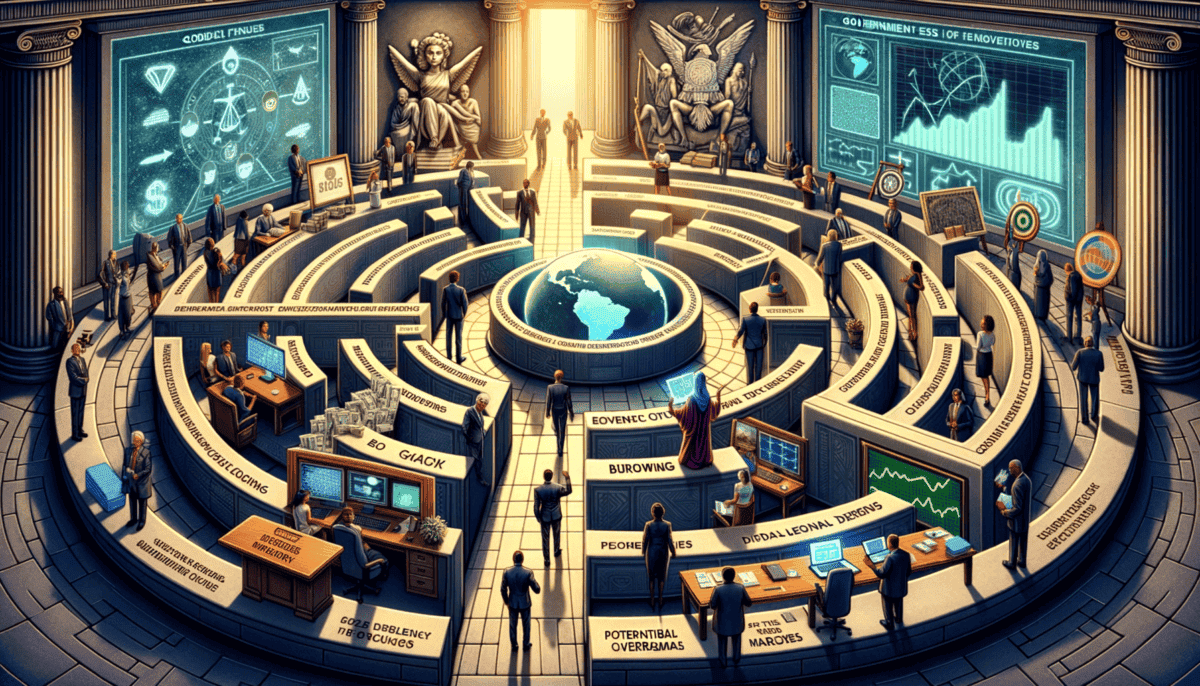The Birth of Borrowing
Once upon a time, in a small town called Moneyville, lived a curious girl named Penny. She loved to learn about money and how it worked. One day, while visiting her grandfather, who worked at the town bank, she asked a very important question.
"Grandpa, why do grown-ups always talk about the government borrowing money?"
Her grandfather smiled and sat down in his favorite chair. "That's a wonderful question, sweetheart. Let me tell you a story about how it all began."
The First Money Problems
Long ago, when our country was very young, it needed money to build things like roads, schools, and bridges. Just like when you need to buy something special but don't have enough money in your piggy bank.
"But Grandpa," Penny interrupted, "couldn't they just wait until they had enough money?"
"Sometimes they couldn't wait," he explained. "Imagine if your school needed to fix its roof before winter. They couldn't wait until summer to fix it, right?"
Penny nodded thoughtfully.
Growing Pains
"The country was like a growing child," Grandpa continued. "It needed new clothes (roads), new books (schools), and sometimes medicine (help during hard times). But just like parents sometimes use credit cards to buy important things, the government started borrowing money."
Penny's eyes widened. "From who?"
"From lots of different people and places! Some people buy special pieces of paper called bonds. It's like letting someone borrow your allowance, but they promise to pay you back later with a little extra."
Learning to Share
The grandfather pulled out an old coin from his desk. "See this? Money used to be made of precious metals like gold and silver. But as the country grew bigger, we needed better ways to handle money."
He drew a simple picture showing how borrowing worked:
| Government Needs | How They Got Help |
| Build Roads | Borrowed from Citizens |
| Help in Wars | Borrowed from Other Countries |
| Build Schools | Borrowed from Banks |
Working Together
"The most important thing to remember," Grandpa said, patting Penny's hand, "is that borrowing isn't bad when it's done carefully. It's like when you borrowed Sarah's jump rope at recess – you took good care of it and gave it back, right?"
Penny smiled proudly. "Yes! And now she lets me borrow it whenever I need to!"
"Exactly! That's how good borrowing works. The government learned to borrow wisely to help everyone in the country have better lives."
That evening, as Penny walked home, she looked at all the things around her – the smooth sidewalk, the bright streetlights, and her beautiful school building. She understood now that sometimes, borrowing helped make good things happen.
Her grandfather's words echoed in her mind: "What matters most is being responsible and always having a plan to pay back what you borrow."
The next day at school, Penny couldn't wait to share what she had learned with her friends during lunch time. She knew this was just the beginning of understanding how money worked in the grown-up world.
The Big Decision
As Penny walked into her classroom the next morning, she noticed her teacher, Ms. Thompson, writing something interesting on the board: “1917 – A Very Important Year!”
“Does anyone know what happened in 1917?” Ms. Thompson asked the class.
Penny raised her hand eagerly. “That’s when World War I was happening!”
“Yes, and something else very important happened that year. Our country made a new rule about borrowing money.”
A New Rule is Born
Ms. Thompson pulled down a colorful chart. “Before 1917, whenever the government needed to borrow money, they had to ask Congress every single time – just like how you ask your parents whenever you need something from the store.”
“But why did they need a new rule?” asked Tommy from the back row.
The Big Change
Ms. Thompson smiled and picked up a jar of marbles. “Let’s pretend each marble is worth one dollar. Before 1917, the government had to ask permission for each marble they wanted to borrow.”
She dropped marbles one by one into the jar. “Can you imagine asking permission every single time? It took too long!”
| Old Way | New Way |
| Ask for each dollar | One big limit to use |
| Slow and difficult | Faster and easier |
Making Things Better
“Instead,” Ms. Thompson continued, drawing a line on the jar, “they decided to set one big limit – like this line. The government could borrow up to that line without asking every time.”
Sarah, sitting next to Penny, raised her hand. “Like when my mom gives me a spending limit at the candy store?”
“Exactly!” Ms. Thompson beamed. “It’s just like that!”
Special People Who Helped
Ms. Thompson showed the class pictures of some important people who helped make this new rule:
Carter Glass was like the team captain. He helped write the new rules about borrowing money. He thought it would help America be stronger during the war.
President Woodrow Wilson agreed with the plan. He knew America needed to be able to help its friends quickly during hard times.
A Smart Solution
“The new rule was like giving the government a special credit card,” Ms. Thompson explained. “But with one very important difference – they could only spend up to a certain amount.”
Penny thought about her piggy bank at home. “So it’s like having a really big piggy bank with a line inside showing when to stop?”
“That’s right, Penny! And just like your piggy bank, it’s important to be careful with how much goes in and out.”
The class spent the rest of the morning making their own pretend debt ceiling jars with markers and clear plastic cups. They practiced deciding how much pretend money they could borrow and talked about being responsible with money.
As the school day ended, Penny couldn’t wait to tell her grandfather about what she had learned. She now understood why 1917 was such an important year for America’s piggy bank!
Around the World Money Tour
The next day, Penny bounced into class excited to learn more. Ms. Thompson had a big colorful map on the wall with little dollar signs pinned to different countries.
“Today, we’re going on a trip around the world!” Ms. Thompson announced with a sparkle in her eye. “We’re going to see how other countries handle their money and borrowing.”
Different Countries, Different Rules
Penny noticed some countries had lots of dollar signs, while others had very few. “Why do some places have more money signs than others?” she asked.
“Well,” Ms. Thompson explained, picking up a globe, “each country has its own special way of managing money. It’s like how different families have different rules about allowance!”
The Global Money Family
Ms. Thompson pulled out some puppets representing different countries:
“Meet Japan,” she wiggled a puppet wearing a kimono. “They don’t have a debt ceiling like we do. Instead, they make new rules each year about borrowing.”
“And here’s Germany,” she showed another puppet. “They have a special rule in their constitution about being careful with money.”
| Country | How They Handle Money |
| United States | Has a debt ceiling |
| Japan | Makes yearly plans |
| Germany | Has special money rules |
Working Together
“The amazing thing,” Ms. Thompson continued, connecting strings between the puppets, “is that all these countries help each other! When one country needs help, others can lend money.”
Big Events Change Everything
Tommy raised his hand. “What happens when something big happens in the world?”
“That’s a great question!” Ms. Thompson pulled out a timeline. “When big things happen, like the time everyone got sick with COVID-19, countries often need to help each other more.”
She drew circles connecting different countries. “It’s like a big friendship bracelet – when one part moves, all the other parts move too!”
Learning from Each Other
The class spent the afternoon making their own pretend countries. Each student got to make up rules about how their country would handle money.
Sarah made her country shaped like a star. “In my country, we save extra money in a rainbow pot!”
Jimmy’s country was shaped like a dinosaur. “My country trades chocolate coins with other countries!”
Penny created her country in the shape of a heart. “In my country, we help others when they need it!”
The Big Money Game
To help everyone understand how countries work together, Ms. Thompson organized a game. Each student’s “country” had to solve a problem by working with other countries.
“Remember,” Ms. Thompson said as they played, “just like in real life, being kind and helping others makes everyone stronger!”
As the bell rang, Penny looked at the world map one last time. She understood now that money wasn’t just about one country – it was about everyone working together to help each other grow and succeed.
The Big Money Battle
Penny walked into class to find Ms. Thompson drawing a big boxing ring on the board. “Today,” Ms. Thompson said with a grin, “we’re going to learn about the biggest money fights in our country!”
The Great Debate
“Sometimes,” Ms. Thompson explained, “grown-ups in Congress have big arguments about borrowing money. It’s like when you and your sister fight over the last cookie – but with billions of dollars!”
Famous Money Fights
Ms. Thompson pulled out a time machine made from a cardboard box. “Let’s travel back in time to see some famous debt ceiling battles!”
“First stop: 2011!” She waved her imaginary time wand. “This was a super big fight. The grown-ups argued so much that some people got worried about their money in the bank!”
“What happened next?” Penny asked, sitting on the edge of her seat.
“Well, at the very last minute, they made a deal. But it was like finishing your homework right before class – not the best way to do things!”
The Money Dance
To help the class understand, Ms. Thompson had everyone play a game. Some kids were Congress members, some were the President, and some were regular people.
| Person | Job in the Game |
| Congress Kids | Make rules about money |
| President Kid | Agrees or disagrees with rules |
| Regular Kids | Wait to see what happens |
Working Together
“The most important thing,” Ms. Thompson said, watching the kids play, “is learning to work together. Even when we disagree, we need to find a way to help everyone!”
Real People, Real Stories
Ms. Thompson shared stories about real people who worked on these big money decisions. “There was a lady named Janet Yellen who worked really hard to help everyone understand why these choices were so important.”
Tommy raised his hand. “Did they always fight about money?”
“Not always,” Ms. Thompson smiled. “Sometimes they worked together really well! Just like how you all shared the playground equipment at recess today.”
Learning from the Past
The class made a big poster showing all the times people argued about the debt ceiling. They used different colored stickers:
- Blue for when people worked together nicely
- Red for when there were big arguments
- ⭐ Gold stars for when they found good solutions
As they put stickers on the poster, Penny noticed something interesting. “Look!” she said. “There are more gold stars near the end!”
“That’s right,” Ms. Thompson nodded. “We’re learning to work together better. Just like you kids learn to share better as you grow up!”
The class bell rang, but Penny stayed behind to look at the poster one more time. She thought about how grown-ups sometimes needed to learn the same lessons kids did – about sharing, working together, and finding fair solutions.
When Money Matters to Everyone
Penny couldn’t wait to tell her family what she learned in class. At dinner, she noticed her parents looking worried while watching the news.
The Ripple Effect
“Mom, why do you look worried?” Penny asked, putting down her fork.
“Well, sweetie,” Mom explained, “remember what Ms. Thompson taught you about the debt ceiling? Those decisions affect our family too.”
Stories from the Neighborhood
The next day, Penny walked around her neighborhood with her dad. They met Mr. Johnson, who owns the local grocery store.
“When the government has money troubles,” Mr. Johnson said, “I worry about keeping prices low for my customers. It’s like a big puzzle!”
They also saw Mrs. Garcia, a teacher at another school. “Sometimes,” she shared, “these big money decisions affect our school supplies and programs.”
The Community Connection
| Person | How They’re Affected |
| Store Owners | Worry about prices |
| Teachers | Think about school supplies |
| Families | Plan their savings |
Learning Together
Back at school, Ms. Thompson started a special project. “Let’s learn how money decisions affect our community!”
The class invited different people to share their stories:
- A bank worker explained saving money
- A construction worker talked about building projects
- A nurse shared about hospital supplies
- A librarian discussed book budgets
Making it Real
“When we understand how these decisions affect real people,” Ms. Thompson said, “we can make better choices when we grow up!”
Taking Action
Penny had an idea. “Can we write letters to tell grown-ups why these decisions matter to kids?” ✉️
“That’s wonderful!” Ms. Thompson beamed. “Let’s do it!”
The class worked together to write letters about:
“Please think about our schools!”
“We want our libraries to have new books!”
“Help our community stay strong!”
Growing Understanding
As they wrote their letters, Penny realized something important. “We’re all like a big family,” she said. “When one person is affected, we all feel it.”
Ms. Thompson nodded proudly. “That’s exactly right, Penny. And that’s why it’s so important for everyone to learn about and care about these big money decisions.”
That evening, Penny shared her letter with her parents. They smiled, knowing their daughter was learning one of life’s most important lessons – how we’re all connected in our big economic family.
Building Tomorrow’s Money World
Penny sat in her treehouse, looking at her piggy bank. She was thinking about everything she learned about money and the debt ceiling.
New Ways to Think About Money
“Money is changing!” Penny told her best friend Sam. “Did you know we might not even use paper money someday?”
Smart Ideas for Tomorrow
Ms. Thompson invited a special guest to class – Dr. Future, a money scientist.
“Kids,” Dr. Future smiled, “let me show you some amazing new ways countries are handling money!”
| New Ideas | How They Help |
| Digital Money | Faster and safer |
| Smart Budgets | Better planning |
| Global Team Work | Countries helping each other |
Making Better Choices
“But how can we make sure we don’t keep having money problems?” Penny asked.
Dr. Future explained some cool new ideas:
- Using computers to make smarter money choices
- Finding new ways to save and spend wisely
- Working together with other countries
- Teaching everyone about money
Working Together
“The best way to fix big money problems is to work together,” Dr. Future said. “Just like you all work together in class!”
Penny’s Big Idea
Penny raised her hand excitedly. “What if we had a Kids’ Money Council? We could help grown-ups think of new ideas!”
Looking Forward
As the school year ended, Penny felt excited about the future. She understood that money problems were big, but she also knew that smart people were working on solutions.
“Remember,” Ms. Thompson said on the last day, “you’re all part of making tomorrow better!”
That night, Penny wrote in her diary: “Money is tricky, but if we work together and think of new ideas, we can make things better for everyone!” ✨
She closed her diary, knowing that the story of money would keep changing, and she would be ready to help write its next chapter.
And as Penny drifted off to sleep, she dreamed of a world where money helped everyone, and no one had to worry about debt ceilings anymore.






